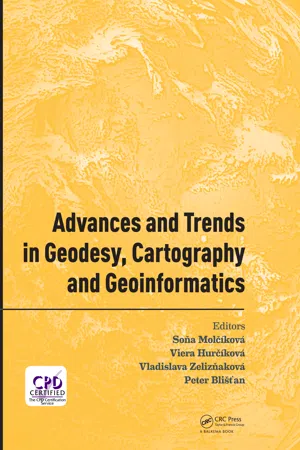Impact of a horizontal refraction on a geodetic network adjustment
Marek Bajtala & Štefan Sokol
Slovak University of Technology in Bratislava, Bratislava, Slovakia
ABSTRACT: The normally used procedure for the geodetic control network adjustment is the least squares method. Assuming that random measurement errors come from the normal probability distribution, estimates obtained using the least squares method are optimal (unbiased and efficient estimate). However, in real conditions, outliers may be part of a set of the measurements, such as the impact of a horizontal refraction. These outliers are causing a violation of the assumption of normality and, therefore, the estimates derived using least squares method lose their optimal properties. For high-quality processing of accurate geodetic control networks, it is necessary to detect outliers and reduce their influence on the resultant estimate using a suitable concept. In the submitted paper, a horizontal geodetic network based on the terrestrial measurements is processed using the least squares method with refraction model and the robust statistical methods. Chosen model of the estimation of horizontal refraction is based on the theoretical basis of defining refraction between two points and the occurrence of refractive blocks in a horizontal geodetic network. The results of experiments indicate that the most accurate results, thus the lowest incidence of the horizontal refraction, are permanent during cloudy weather. If the measurement is done during sunny weather, it is more appropriate to use the least squares method supplemented with a horizontal refraction model to process a horizontal geodetic network.
1 Introduction
For processing a control network, it is mostly assumed that measured values are affected by the errors, which have a character of normal distribution of the probability N(μ, σ 2 ). However, measured quantities come from a strictly normal distribution only if gross errors, mistakes and systematic errors are filtered out (Gasincova 2011b). Random character of surveying measurements is conditioned by the measurement itself, where multiple measurements of a particular quantity deliver similar, however different results. Different results may also be caused by the impact of refraction, respective to the impact of current weather conditions during the measurement. This paper deals with the processing of three experimental measurements in the horizontal control network using a model that takes into account the impact of horizontal refraction and its results are linked to the results obtained in the publications (Bajtala, 2006), (Bajtala, 2007).
2 Linear Model Considering Refraction
Creation of linear model considering refraction (LMCR) is based on a standard procedure using the least square method (LSM) which is expanded by the effect of horizontal refraction (Bajtala, 2006). The given model can be written as follows:
(1)
where estimate of the unknown parameters can be calculated:
(2)
where , , and
Final covariance matrix of the unknown parameters has the following form:
(3)
By means of the above described model, we can estimate individual horizontal refractions. Analyses of the identifiability of the estimated horizontal refraction can be carried out by testing null hypothesis. Analysis is based on the knowledge of the sub-matrix of the refraction components (Bajtala, 2006). The null hypothesis for rejecting the existence of horizontal refraction can be written as follows (Kubackova, 2000):
(4)
where is a random variable with chi‐squared distribution and p degrees of freedom, where p is the number of considered refraction coefficients in the control network.
3 Robust Statistical Methods
Robust estimation can be applied in basic or extended linear models. M-estimates are mostly used in surveying because they are flexible also for generalized linear models (Hampacher, 2011), (Trasak, 2011). Robust M-estimates, implemented in LSM, are based on a consecutive iterative calculation. To create iterative calculation, which more effectively searches and detects outliers i.e. defines robust weight matrix W for each iteration, it is necessary to calculate standardized correction v i from the correction estimated by LSM. Standardization in LSM is adequate to ration of the calculated correction v ; and particular standard error u, because real errors are unknown and their estimates are corrections v i :
Consequently, robust matrix W can be defined as follows:
(6)
Calculation is iterative, as null iteration is considered an LSM estimate that is not robust. Estimated value of the correction v i using LSM is considered as equally precise values against other corrections, i.e. the correction would have theoretical value w i (v l ) = 1. In such a case, that shape of influence function ψ(v l ) is not bounded, i.e. it is not robust because does not take into account any outliers, respectively intervals of values. Then, it can be stated that corrections are equal and equally effect the calculation of the accuracy and LSM estimate. Consequently, for 1. iteration enters into the normal equations the robust weight matrix W, which acquired certain values depending on their equation and detected outliers, and M‐estimate of the first estimation is created. By means of standardized corrections and consequent iterations are calculated new robust weights , which form weight matrix W n+1 a consequently also M‐estimate:
(7)
where A is a matrix of the above described model of refraction and is formed by sub‐ matrixes F, nd matrix H. Of existing Mstimates has been used for calculation—estimate of Cauchy’s distribution (Hampacher, 2011), (Třasák, 2011), (Gašincová, 2011a ), (Giu 1998) and we...
